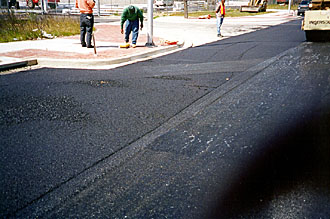U.S. Department of Transportation
Federal Highway Administration
1200 New Jersey Avenue, SE
Washington, DC 20590
202-366-4000
Focus
| Accelerating Infrastructure Innovations |
Publication Number: FHWA-SA-98-025
Date: September 1998
Maryland, a member of the Superpave Lead States team, continues to move forward with implementation of the Superpave system. In 1996, the Maryland Department of Transportation (DOT) adopted the Superpave binder specification, and starting next year the DOT will specify Superpave mixes for all of its asphalt paving projects. The Maryland DOT's materials laboratories will thus no longer test conventional asphalt mixes for compliance with the State's old specifications. This change means cities such as Baltimore and other local governments will have a difficult time obtaining conventional binders and mixes, says Bob Sneddon of Maryland contractor P Flanigan & Sons, Inc., as most contractors will convert totally to the Superpave system.
"Flanigan no longer stocks viscosity-graded binders. In addition, we're trying to explain to the city of Baltimore and the surrounding counties that specifying the old State mix for their projects is no longer relevant, as the State will no longer certify that these mixes meet their specs," says Sneddon.
To explain the changes to the city of Baltimore, Flanigan & Sons set up a meeting with Baltimore Department of Public Works (DPW) Director George Balog and his staff in March. At the meeting, staff from Maryland DOT, the Maryland Asphalt Pavement Association, and the Federal Highway Administration's (FHWA) headquarters and Maryland division office discussed the Superpave system and explained its benefits.
"It was a true partnering of the State highway agency, FHWA headquarters, the FHWA division office, the contractor, and the Baltimore DPW to disseminate information and create interest in doing a Superpave project," says Jitesh Parikh of FHWA's Maryland division, who made a presentation at the meeting.
The result: "We all came together to say, 'hey, let's try this,'" says Dan Zimmerman of Baltimore DPW.
The first step was to find a suitable project for the city's first Superpave pavement. Parikh suggested a project to reconstruct a 2.4-km (1.5-mi) stretch of Boston Street in Baltimore, which called for placement of a 5-cm (2-in) asphalt overlay on a new 23-cm (9-in) jointed portland cement concrete pavement. Boston Street carries a high volume of traffic, including a large number of trucks. This traffic can cause severe rutting, particularly at intersections. Albert Hinojosa of FHWA's Maryland division, who has worked closely on the design and construction of the Boston Street project, concurred with Parikh's suggestion.
"Baltimore was concerned about rutting," says Parikh. "The contractor and I told the chief engineer that rutting was one of the reasons why Superpave was developed."
Baltimore DPW and Hinojosa then issued a change order specifying the use of a 12.5-mm Superpave mix with a PG70-22 binder.
Sneddon says the project was a perfect opportunity to use a Superpave mix on an urban street. "We thought Boston Street would be a great place to try Superpave because it could be placed on a brand new concrete base. It's hard to find a city street with a uniform base material, which is important to evaluate the performance of the pavement."
The project was a learning experience for both the city and the contractor. "The city's specs don't allow vibratory compaction," says Sneddon. "We were interested in seeing what specific density could be achieved with static compactors." With the spec mandating 92 percent to 97 percent of maximum theoretical density, Flanigan & Sons achieved 94 percent using three static compactors.
Baltimore DPW benefited from having an experienced contractor on board. "It was our first Superpave project," says Zimmerman. "It was an opportunity to have people on board who are experienced with the placement of Superpave pavements." Following the success of the Boston Street project, Baltimore will also be using the Superpave system to rehabilitate the Jones Falls Expressway (Interstate 83).
Maryland DOT personnel and contractors across the State are taking steps similar to those of Flanigan & Sons to inform local agencies about the Superpave system and what it means for them. Under the leadership of Maryland DOT's Larry Michael, Superpave training was held for approximately 650 persons earlier this year, including county and municipality personnel. This training was provided by a joint team of instructors representing Maryland DOT, FHWA, contractors, and industry.
For more information, contact Jitesh Parikh at FHWA (phone: 410-962-4342, x128; fax: 410-962-4054; email: jitesh.parikh@fhwa.dot.gov).

The Baltimore Department of Public Works recently replaced this 2.4-km (1.5-mi) stretch of Boston Street with the city's first Superpave pavement.